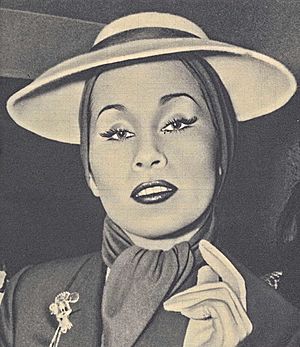Yma Sumac facts for kids
Quick facts for kids
Yma Sumac
|
|
|---|---|

Sumac in Italy in 1954
|
|
| Background information | |
| Birth name | Zoila Emperatriz Chavarri Castillo |
| Born | September 13, 1922 Callao, Peru |
| Died | November 1, 2008 (aged 86) Los Angeles, United States |
| Genres | |
| Occupations |
|
| Instruments | Voice |
| Years active | 1938–1976 1984–1997 |
Zoila Augusta Emperatriz Chavarri del Castillo (born Zoila Emperatriz Chavarri Castillo; September 13, 1922 – November 1, 2008), known as Yma Sumac, was an amazing singer from Peru. Her stage name, "Ima sumaq," means "how beautiful" in the Quechua language. People also called her the Queen of Exotica music, and she helped make World music popular.
In 1956, Yma Sumac earned a Guinness World Record for having the widest singing range. Her first album, Voice of the Xtabay (1950), became number one on the Billboard 200 list. One of its songs, "Virgin of the Sun God (Taita Inty)," also hit number one on the UK Singles Chart. This album sold a million copies around the world, making her a huge star in the 1950s. Other popular albums included Legend of the Sun Virgin (1952), Fuego del Ande (1959), and Mambo! (1955).
In 1951, Sumac was the first female singer from Latin America to perform on Broadway. She developed a special singing style called "double voice" or "triple coloratura" in her song "Chuncho (The Forest Creatures)" (1953). She also performed at famous places like Carnegie Hall. In 1960, she became the first Latin American woman to get a star on the Hollywood Walk of Fame. Later, she toured the Soviet Union, selling over 20 million tickets. Variety magazine reported in 1974 that Sumac had performed more than 3,000 concerts worldwide, which was a record for any performer. She has sold over 40 million records, making her the best-selling Peruvian singer ever.
Contents
Early Life and Beginnings
Yma Sumac was born Zoila Emperatriz Chavarri Castillo on September 13, 1922, in Callao, Peru. Her family, who were middle class, later moved to Cajamarca, where she grew up. Her father, Sixto Chavarri, was a community leader, and her mother, Emilia Castillo, was a schoolteacher. Yma was the youngest of six children. She spent her childhood in the Andean mountains, where she would imitate the sounds of birds and other animals. This helped her develop her amazing vocal range without even trying.
In 1934, she moved to Lima to live with relatives. She was taught at home until 1935, when she started attending a Catholic school.
Becoming a Star
Yma Sumac's first known performance was on August 16, 1938, with Moises Vivanco at a special event in Callao. She finished high school in 1940. In 1943, she recorded at least 18 Peruvian folk songs in Buenos Aires, Argentina. These early songs were for the Odeon label and featured Moisés Vivanco's group, Compañía Peruana de Arte. This group included 16 Peruvian dancers, singers, and musicians.
In 1950, Les Baxter discovered her, and she signed a record deal with Capitol Records. This is when she started using her stage name, Yma Sumac. Her first album, Voice of the Xtabay, made her very famous. She performed at big venues like the Hollywood Bowl and Carnegie Hall.
In 1950, she went on her first tour to Europe and Africa. She performed at the Royal Albert Hall in London and the Royal Festival Hall for the future Queen of England. She gave over 80 concerts in London and 16 in Paris. A second tour took her to the Far East, including Persia, Afghanistan, Thailand, and Australia. She became so popular in countries like Greece, Israel, and Russia that her two-week stays turned into six months.
During the 1950s, she released many popular lounge music albums. These albums featured Incan and South American folk songs arranged in a Hollywood style. She worked with famous musicians like Les Baxter and Billy May. Her amazing voice, unique look, and exciting stage presence made her a big hit with American audiences.
In 1951, Sumac appeared in a Broadway musical called Flahooley. She played a foreign princess who brings Aladdin's lamp to an American toy factory for repairs. The show's music was by Sammy Fain and Yip Harburg, but Yma's three songs were written by Vivanco. Flahooley didn't run for long, but the album of the show is still popular with some fans.
The 1950s were the years when Sumac was most famous. She performed at Carnegie Hall, the Roxy Theatre with Danny Kaye, and in Las Vegas nightclubs. She also toured South America and Europe. She released several hit albums for Capitol Records, such as Mambo! (1954) and Fuego del Ande (1959). During this time, she also appeared in the films Secret of the Incas (1954) with Charlton Heston and Omar Khayyam (1957).
She became a U.S. citizen on July 22, 1955. In 1959, she sang Jorge Bravo de Rueda's classic song "Vírgenes del Sol" on her album Fuego del Ande. Sumac and Vivanco divorced in 1957 but remarried that same year. They divorced again in 1965. Due to money problems, Sumac and the Inka Taky Trio went on a world tour in 1960 that lasted five years. They performed in 40 cities in the Soviet Union for over six months. A film was made about parts of this tour. After that, they toured Europe, Asia, and Latin America. Their concert in Bucharest, Romania, was recorded as the album Recital, which is her only live concert album. Sumac performed less often during the rest of the 1960s.
Personal Life
Yma Sumac married Moisés Vivanco on June 6, 1942. After they married, Moisés and Yma toured South America and Mexico with a group of fourteen musicians called Imma Sumack and the Conjunto Folklorico Peruano. In 1946, Sumac and Vivanco moved to New York City. There, they performed as the Inka Taqui Trio. Sumac sang the high parts, Vivanco played guitar, and her cousin, Cholita Rivero, sang the low parts and danced. The group didn't become very famous at first, but their performance at the South American Music Festival in Carnegie Hall received good reviews. In 1949, Yma gave birth to their only child, Carlos.
Amazing Vocal Range
Some people say Yma Sumac had a five-octave vocal range, but other reports and recordings show she had four and a half octaves when she was at her best. A typical trained singer usually has a range of about three octaves.
In one live recording of "Chuncho," she sang a range of over four and a half octaves, from a very low B2 to a very high G#7. She could sing notes in the low baritone range and also notes higher than a normal soprano. You can hear both her very low and very high notes in the song "Chuncho (The Forest Creatures)" (1953).
In 1954, music critic Virgil Thomson said Sumac's voice was "very low and warm, very high and birdlike." He noted that her range was "very close to five octaves, but it didn't sound strange or inhuman." In 2012, sound expert John H. Haley compared Sumac's voice quality to famous opera singers like Isabella Colbran and Maria Malibran.
Yma Sumac could sing notes from above a coloratura soprano (very high) to the low notes of a bass singer. She had one of the widest vocal ranges ever. She could sing notes that fit the tessitura (comfortable range) of many voice types: sopranino, soprano, mezzo-soprano, contralto, tenor, baritone, and bass. She was also known for her "triple coloratura" or "trill of the birds," a unique singing technique. Her singing voice ranged from B2 to G#7.
One source even claims that in the song "K'arawi," she reached a D8, which would mean her vocal range was over five octaves, maybe even six!
Later Career
In 1971, Sumac released a rock album called Miracles. She performed concerts from time to time during the 1970s in Peru and later in New York. In the 1980s, she started her career again with the help of Alan Eichler. She performed many concerts in the United States and other countries. These included shows at the Hollywood Roosevelt Cinegrill and New York's Ballroom in 1987, where her shows were sold out for seven weeks.
In 1987, she recorded "I Wonder" from the Disney film Sleeping Beauty for an album called Stay Awake. This album featured songs from Disney movies. She also sang "Ataypura" on the Late Night with David Letterman TV show on March 19, 1987. She recorded a new German "techno" dance song called "Mambo ConFusion."
In 1989, she sang again at the Ballroom in New York. She also returned to Europe for the first time in 30 years to perform in a New Year's Eve TV special in Brussels and a show in Paris. In March 1990, she played the role of Heidi in Stephen Sondheim's Follies in Long Beach, California. This was her first serious theater role since Flahooley in 1951.
She also gave several concerts in the summer of 1996 in San Francisco and Hollywood. She performed two more concerts in Montreal, Canada, in July 1997 as part of the Montreal International Jazz Festival. In 1992, she chose not to appear in a German TV documentary about her called Yma Sumac – Hollywoods Inkaprinzessin (Yma Sumac – Hollywood's Inca Princess).
When lounge music became popular again in the late 1990s, Yma Sumac's fame grew. Her song "Ataypura" was featured in the Coen Brothers film The Big Lebowski.
Her song "Bo Mambo" was used in a commercial for Kahlúa liquor. It was also sampled (a part of it was used) in the song "Hands Up" by The Black Eyed Peas. The song "Gopher Mambo" was used in several films, including Ordinary Decent Criminal, Happy Texas, and Confessions of a Dangerous Mind. "Gopher Mambo" was also used in a Cirque Du Soleil show called Quidam, in the Russian TV show Kukhnya, and in an iPhone commercial in 2020. The songs "Goomba Boomba" and "Malambo No. 1" appeared in Death to Smoochy. A part of "Malambo No. 1" was used in Robin Thicke's song "Everything I Can't Have." Yma Sumac is also mentioned in the lyrics of the 1980s song "Joe le taxi" by Vanessa Paradis. Her album Mambo! is shown in the music video for Belinda Carlisle's "Mad About You." "Gopher Mambo" is the opening song in the British TV show "Ten Percent."
On May 6, 2006, Sumac flew to Lima, Peru. There, she received the Orden del Sol award from Peruvian President Alejandro Toledo. She also received the Jorge Basadre medal from the Universidad Nacional Mayor de San Marcos.
Death
Yma Sumac passed away on November 1, 2008, at the age of 86. She had been diagnosed with colon cancer nine months earlier. She was buried at the Hollywood Forever Cemetery in Los Angeles, California.
On September 13, 2016, a Google Doodle honored Yma Sumac. On September 20, 2022, a new statue of her was revealed at her burial place at the Hollywood Forever Cemetery. This was to celebrate what would have been her 100th birthday.
Myths About Her Life
Stories published in the 1950s claimed that Yma Sumac was an Inca princess, directly related to Atahualpa, the last Inca emperor. In 1946, the government of Peru even supported her claim to be descended from Atahualpa. However, her biographer, Nicholas E. Limansky, said that her Inca royal origin was not true. He explained that "Hollywood took this nice girl who wanted to be a folk singer, dressed her up and said she was a princess. And she acted like it."
Discography
A recording session in Argentina in 1943 included 23 songs, released on 78 rpm Odeon Records. Sumac's 1952 album Legend of the Sun Virgin was reissued in 2020 by a Spanish record label called Ellas Rugen (Ladies Who Roar) Records. This label focuses on great female Latin American singers from the second half of the 20th century.
Albums
- Voice of the Xtabay (Capitol, 1950)
- Legend of the Sun Virgin (Capitol, 1952)
- Inca Taqui (Capitol, 1953)
- Mambo! (Capitol, 1954)
- Legend of the Jivaro (Capitol, 1957)
- Fuego Del Ande (Capitol, 1959)
- Recital (Electrecord, 1961)
- Miracles (London, 1971)
Compilations
- The Spell of Yma Sumac (Pair, 1987)
- Amor Indio (Saludos Amigos, 1994)
- Shou Condor (Promo Sound, 1997)
- The Ultimate Yma Sumac Collection (Capitol, 2000)
- Virgin of the Sun God (Old Fashion, 2002)
- The Exotic Sounds of Yma Sumac (Sounds of the World, 2002)
- Queen of Exotica (Universe, 2005)
Filmography (partial)
| Year | Title | Role | Notes |
|---|---|---|---|
| 1954 | Secret of the Incas | Kori-Tica | performs "Taita Inty", "Tumpa!", "Ataypura!" |
| 1957 | Omar Khayyam | Karina | performs "Lament" |
| 1958 | Música de siempre | Herself | performs "Chuncho" |
| 1960 | Las canciones unidas | Herself | performs "Taita Inty" |
Images for kids
See also
 In Spanish: Yma Súmac para niños
In Spanish: Yma Súmac para niños



